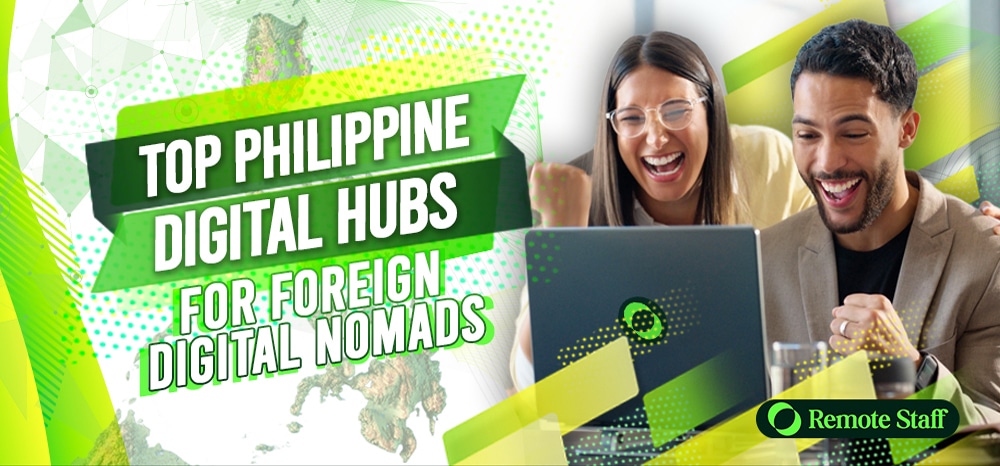The Philippines is known for its white sand beaches and tropical climate, making it perfect for beach lovers who want to snorkel, dive, surf, or relax all day in the sun.
With over 7,640 islands offering diverse scenery and activities and the rise of remote work in the Philippines, a growing number of foreign digital nomads have also considered the Philippines a home.
Unlike other Asian countries, English is widely spoken in the Philippines. In fact, it’s considered as the third-largest English speaking country in the world. Little wonder then that thousands of Americans opt to explore the country’s natural beauty while running their businesses remotely.
Why the Philippines is a Prime Destination for US Digital Nomads
The Philippines has long had ties to American culture. From 1898 to 1946, the Americans colonized the country, making English the official language while reforming the education system.
As a result, Filipinos speak and write fluent English, making it easier for Americans to work in the Philippines. According to studies, about 900,000 tourists in the Philippines are from the United States, and the government aims to raise this number to a million as of this writing.
Unsurprisingly, the number of U.S. digital nomads in the Philippines has grown due to several factors, including:
- Affordable living costs;
- Scenic landscapes;
- Growing acceptance of remote work;
- Philippines time zone alignment for U.S. remote workers;
- Cultural appeal of the Philippines; and
- Flexible long-stay visa options.
But with over 7,000 islands to choose from, where should an American digital nomad go? Here are some top, affordable destinations to consider:
Manila: A Fast-Paced Digital Hub for Remote Work
As the capital of the Philippines, Manila is a popular choice for remote professionals.
It offers many co-working spaces, shopping centers, and cultural attractions. Plus, its central location makes it a convenient base for frequent travel to other places outside the city.
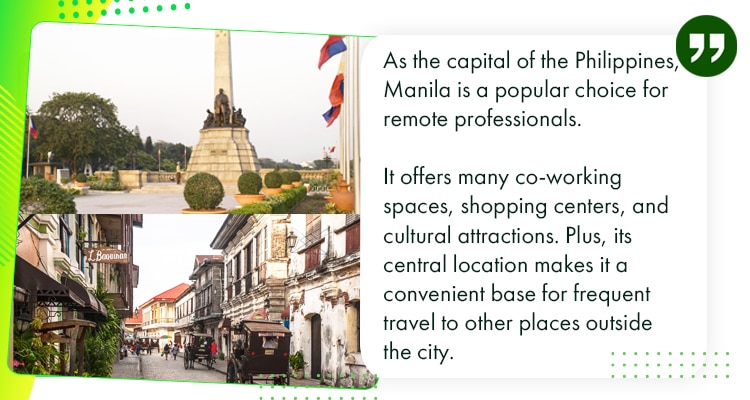
Digital nomads planning to stay in Manila should consider the following:
Top Co-Working Spaces in Manila
Many digital nomads use co-working spaces because they offer a professional setting without the long-term commitment (and cost) of renting an office. It also gives them a chance to network with other freelancers, business owners, or remote workers.
Here are some co-working spaces to consider if you’re in Metro Manila:
- WeWork – WeWork in RCBC Plaza, Makati offers high-speed Wi-Fi, private offices, shared workspaces, and event spaces. It’s perfect for large teams, freelancers, and startups looking for an Instagrammable place with a lot of natural light and space.
- CommonGround – This popular co-working space in Bonifacio Global City (BGC), Taguig offers shared workspaces and private offices, plus a rooftop area, wellness programs, and community events. It’s ideal for creatives and entrepreneurs seeking to work and network.
- Acceler8 – You can also visit Acceler8, a co-working space in Makati City. Like the others, it offers private offices and meeting rooms. This space also provides IT support and printing services if you need to handle paperwork.
Internet Speed and Connectivity for Digital Nomads
Manila offers reliable internet speed compared to other locations. Major business districts like Makati, BGC, and Ortigas, where most co-working spaces are located, have high-speed fiber internet.
Typical internet speeds in these areas range from 50-100 Mbps, with some places offering even faster connections. Moreover, local telecommunication providers like PLDT, Globe, and Converge ICT are expanding their fiber coverage.
Additionally, Elon Musk’s Starlink has entered the Philippine market, enhancing connectivity and helping digital nomads work efficiently.
Cost of Living and Housing Options
The cost of living in Manila varies depending on lifestyle, with rent often being the biggest expense.
Apartments in business areas like BGC and Makati can cost $500-1500 per month, while more affordable options in less crowded areas range from $300-700.
Utilities and internet can add another $50-100 per month while groceries cost an average of $90-200 monthly. Dining out is also cheaper than in the U.S., with local meals costing $3-6 and mid-range restaurants $10-20 per meal.
Key Attractions and Lifestyle Opportunities
Manila offers different attractions, from historical landmarks to shopping centers. Here are a few examples:
- Intramuros – Known as the Walled City, Intramuros highlights Spanish colonial history with landmarks like Fort Santiago and San Agustin Church.
- National Museum of the Philippines – The national museum holds an impressive collection of Filipino masterpieces, including paintings, sculptures, and pre-colonial artifacts.
- Binondo (Chinatown) – Binondo, world’s oldest Chinatown, is famous for its food trips, temples, and vibrant streets.
- SM Mall of Asia (MOA) – SM MOA is one Asia’s largest malls, featuring a wide range of dining, shopping, and entertainment options, including an ice-skating rink and a large cinema.
- Cultural Center of the Philippines – CCP is a hub for art performances such as theater, dance, music, and visual arts exhibitions.
Cebu: A Balance of Work and Leisure for Digital Nomads
Digital nomads are also traveling to Cebu, the first capital of the Philippines.
Dubbed as the Queen City of the South, Cebu provides an ideal balance of work and leisure for digital nomads. It features beautiful beaches, lively festivals, and vibrant food scenes.
Let’s take a closer look.
Why Cebu Appeals to U.S. Digital Nomads
Cebu has become an appealing destination due to its close proximity to stunning beaches, waterfalls, and diving spots, making it a paradise for digital-nomads-slash-outdoor-enthusiasts.
As the oldest city in the Philippines, it has a vibrant culture and historic landmarks like the Magellan’s Cross and the Basilica Minore del Sto. Niño de Cebu.
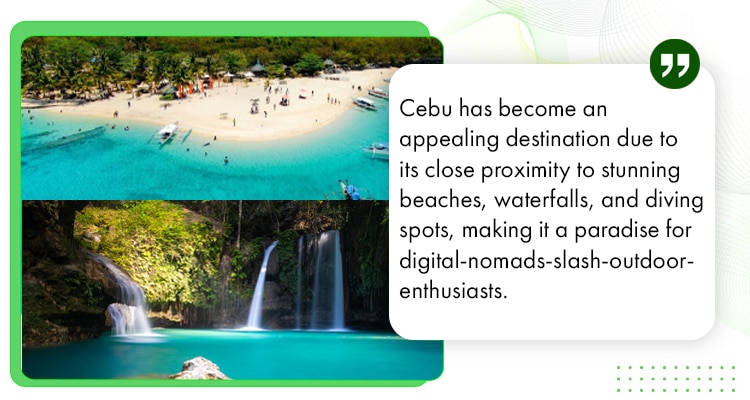
Every January, Cebu hosts the annual Sinulog festival which features traditional dances, street parades, and colorful costumes, drawing millions of visitors from different parts of the country.
Popular Co-Working Spaces in Cebu
American digital nomads have plenty of co-working space options in Cebu.
Whether you prefer laidback workspaces or professional corporate settings, there are plenty of choices, such as:
- The Company Cebu – Located in Cebu IT Park, The Company offers modern amenities with flexible workspaces, private offices, and conference rooms. It’s ideal for digital nomads seeking an artsy vibe, an amazing view, and natural lighting to stay productive.
- KMC Skyrise 4B – Another popular option is KMC Skyrise. Aside from conference rooms and open co-working spaces, it also has massage facilities, yoga rooms, and wellness centers. Plus, it’s close to various coffee shops, restaurants, and hotels.
- Enspace Cebu – If you prefer Zen-like environments, Enspace Cebu is perfect. It offers a premium work experience with large windows for natural light and panoramic views of Cebu Business Park, providing a comfortable, open space to work.
Affordable Cost of Living and Quality of Life
Cebu has an affordable cost of living. A comfortable one-bedroom apartment costs around $300-600 per month, depending on the area. Utilities and the internet average about $100, based on usage.
Food in Cebu is inexpensive with local markets and street food offering tasty meals for $2-3. Western-style restaurants are available too, but they cost less than in major cities like New York.
Getting around Cebu is also easy with public transportation or ride-sharing apps, with fares starting at less than $1.
Exploring Cebu’s Beaches and Nature Spots
Cebu is a paradise for nature and beach lovers. It has clear waters, mountain peaks, waterfalls, and diving spots, such as:
- Bantayan Island – Bantayan is famous for its white sand beaches and crystal clear waters. It’s about 5-6 hours from Cebu City by land and ferry, but a direct flight now takes only 30 minutes.
- Osmeña Peak – Osmeña Peak, the highest point in Cebu, offers stunning views of jagged hills and surrounding islands. It’s a popular spot for hikers and nature-lovers, with panoramic sunrise and sunset views.
- Kawasan Falls – Kawasan is one of Cebu’s most famous waterfalls and a popular canyoneering spot. Many visitors, including digital nomads, swim, trek, and jump off cliffs along the river route.
- Oslob – In Oslob, you can swim with whale sharks, the gentle giants of the sea. If you prefer to relax, you can also visit Tumalog Falls, a peaceful spot to unwind after your adventures.
- Malapascua Island – Cebu has excellent diving spots like Malapascua, known for its beautiful coral gardens and thresher sharks. It also offers pristine beaches, making it an ideal spot for both relaxation and adventure.
Davao: Safe and Budget-Friendly for Digital Nomads
Many American digital nomads are heading to Davao in the southern part of the Philippines. With low crime rates and ranking 2nd in Southeast Asia for safety, it’s an appealing destination for remote workers, especially foreign nationals.
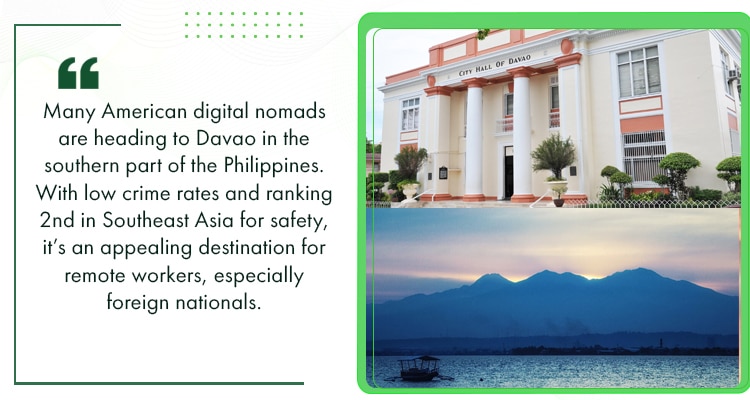
Aside from safety, Davao is known for its affordable accommodation, dining, and transportation. It also offers nearby beaches and mountains, providing a budget-friendly environment for relaxation and work.
Here are some things to consider if you’re an American digital nomad traveling to Davao:
Best Co-Working Spaces in Davao
Co-working spaces are becoming popular in Davao as the remote work infrastructure in the Philippines grows. These spaces typically offer modern amenities, high-speed internet, and a productive work environment.
Here are some good examples:
- Regus Davao – This co-working space in the heart of the city features meeting rooms, private offices, and fast internet. With large windows, natural light, and ergonomic chairs, it’s ideal for digital nomads.
- WFC Coworking & Study Cafe – You can also drop by WFC for standing desks, free coffee, and a premium co-working experience at reasonable rates. They offer height-adjustable desks, semi-private pods, and meeting rooms.
- Skynora Corp – Skynora Corp offers digital nomads all the business essentials, including high-speed internet, administrative support, and printing services. Their fully-furnished, state-of-the-art workspaces make it a comfortable workspace.
Safety, Cost of Living, and Amenities for U.S. Expats
Davao offers a sense of security for expatriates, allowing them to live and work comfortably with minimal concerns about personal safety.
Many digital nomads prefer Davao because its cost of living is more affordable than in many U.S. and Philippine cities.
For example, a one-bedroom apartment typically costs between $200-400 per month. Daily living expenses in Davao are also lower. A meal at a local restaurant typically costs around $3-5.
Attractions: Mount Apo, Samal Island, and Cultural Highlights
Davao has its fair share of natural beauty and cultural experiences. Here’s a closer look at its top attractions:
- Mount Apo – Mount Apo, the highest peak in the Philippines, provides challenging treks for nature enthusiasts and adventure seekers.
Hikers navigate through mossy forests and volcanic terrain to reach the summit, where they can enjoy breathtaking panoramic views of the surrounding landscape and nearby islands.
- Samal Island – Davao boasts islands like Samal, known for its white sand beaches, snorkeling, and diving. Highlights include Pearl Farm Beach Resort with its luxurious accommodations and Hagimit Falls, ideal for a refreshing dip after a day of exploring.
- Davao Museum – You can also visit the Davao Museum, which shows the region’s rich history, local heritage, and indigenous cultures.
Baguio: A Cool, Calm, and Creative Hub
If you’re not into beaches, consider heading to the mountainous region of northern Luzon, where Baguio City is located. Baguio is a great destination for American digital nomads who prefer a cool and calm environment.
Baguio’s peaceful surroundings makes it perfect for focused work and relaxation. The city’s numerous parks and cool weather also offer plenty of opportunities for outdoor activities without the risk of sunburns.
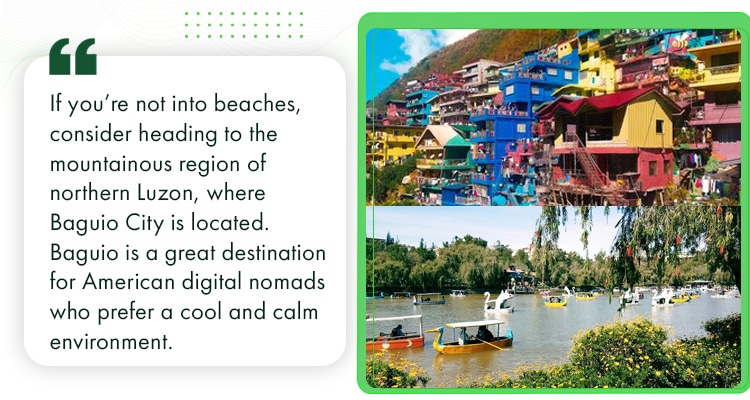
Thus, if you’re planning to work in Baguio, here are some things to consider:
Working in Baguio: Benefits for Productivity
Baguio’s cool climate offers a refreshing break from the heat of lower-altitude cities like Manila, Cebu, and Davao. This cooler weather helps maintain focus and reduces the fatigue often associated with working in warmer environments.
Additionally, Baguio has many art galleries, creative hubs, and cultural events, providing inspiration and relaxation for digital nomads. Together, these factors make the city an excellent choice for those seeking a balance of comfort, inspiration, and productivity.
Co-Working Spaces and Remote Work Communities
Baguio is smaller and less developed than Manila or Cebu, but it still has co-working spaces for freelancers, entrepreneurs, and digital nomads.
Here are some of them:
- Calle Uno Co-Working Space – Calle Uno is a unique co-working space in a charming, repurposed heritage house. It offers comfortable workstations with communal tables and themed interiors that showcase the city’s charm and history.
- Craftery Coworking Hub – Many digital nomads recommend Craftery Coworking Hub. It has fast, stable WiFi and a quiet environment, plus board games for when you want to relax.
- I Need Space – If you’re after a nice atmosphere, I Need Space offers a great view of Baguio City. They have unlimited brewed coffee and fast internet, making it a good spot to work – or just unwind.
Affordable Living in the Highlands
Baguio offers affordable housing, with rentals ranging from $175-350 per month. The cool climate also reduces the need for air conditioning, which helps you cut down on electricity costs.
Fresh produce is easy to find at local markets, with vegetables costing less than $2 during harvest season. Dining out is affordable and local meals are usually priced at $2-3 each.
Meanwhile, public transportation is cheap and convenient, thanks to jeepneys and taxis around the city.
Local Culture and Nature-Focused Lifestyle
Baguio, known as the “Summer Capital of the Philippines,” is famous for its stunning natural landscapes. Aside from digital nomads, both local and foreign tourists visit the city to enjoy its many attractions, including:
- Burnham Park – Burnham Park, located in the city center, is an all-in-one recreational area where you can go biking, strolling, or boat riding on the lagoon.
- Botanical Garden – You can also visit Botanical Garden, a place known for its art installations, traditional Ifugao huts, and peaceful landscapes filled with flowers and greenery.
- Camp John Hay – American digital nomads may feel a sense of home in Camp John Hay, a former U.S. military base. Now a mixed-use leisure estate, it offers hiking trails, pine tree forests, and other tourist attractions.
- Tam-Awan Village – To learn more about Baguio, visit Tam-Awan Village, a reconstructed traditional Cordillera village showcasing indigenous art galleries and traditional Ifugao and Kalinga huts.
Siargao: Work and Play in the Surfing Capital of the Philippines
Siargao Island is a favorite among American digital nomads seeking a laid-back, tropical lifestyle. As the Surfing Capital of the Philippines, the island is home to world-class surf spots, particularly Cloud 9, that draw surfers from all over the world.
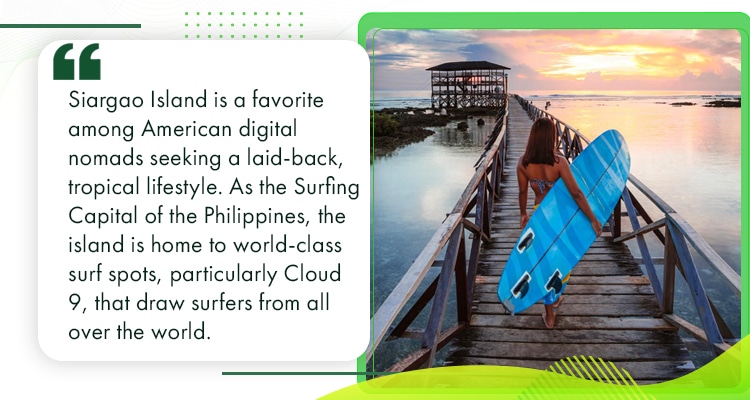
However, surfing is just one of many activities Siargao offers. You can also enjoy island hopping, paddleboarding, and exploring hidden lagoons. Thus, if you’re looking for a beach paradise where you can work and play after a long day, Siargao is the place to go.
But before booking your flight, here are a few things you should know.
Siargao’s Unique Appeal for Digital Nomads
For many digital nomads, Siargao is a breath of fresh air. It’s far from the hustle and bustle of city life, offering them a chance to experience the traditional island charm.
After work, they can unwind by exploring nearby islands, surfing, or simply relaxing on the beach. Outdoor enthusiasts can also explore lagoons, mangroves, and remote islands.
Additionally, the island’s welcoming, tight-knit community encourages digital nomads to stay longer and perhaps even make Siargao their second home.
The unique blend of island charm and diverse foreign cultures appeals to digital nomads seeking both productivity and leisure in a tropical paradise.
Co-Working and Co-Living Spaces on the Island
Many co-working and co-living spaces in Siargao have open-air setups with beach or garden views.
They’re also close to popular spots so digital nomads can easily take a swim or go surfing before or after work. Let’s take a look:
- Cocospace – Cocospace is in a quiet area of Siargao, just 10 minutes from Cloud 9. This co-working space offers great features like Starlink internet, ergonomic chairs, focus rooms, call booths, outdoor workspaces, and even a swimming pool!
- Spotted Pig Cafe – If you’re looking for a cozy, stylish cafe to work in, Spotted Pig is a great option. It has a welcoming atmosphere, known for its brewed coffee and a variety of fresh, homemade meals and sweets.
- Bravo Siargao – Bravo offers peaceful common areas for work, with the sound of crashing waves in the background. It also has a strong internet connection that’s ideal for Zoom meetings.
Balancing Work with Surfing and Island Adventures
Siargao has something for everyone, whether you’re into surfing or not. Here are some must-see places:
- Cloud 9 Surfing Spot – Cloud 9 got its name from the powerful right-hand reef break that resembles the number 9 during peak seasons. It’s a world-class surf spot, and Siargao hosts international surfing competitions there every October.
- Magpupungko Rock Pools – If you love natural pools, don’t miss Magpupungko. Its clear waters and stunning rock formations are perfect for swimming, snorkeling, and cliff diving.
- General Luna – This lively town is at the heart of Siargao’s surf culture. It also has surf shops, restaurants, local eateries, and coffee shops for relaxing. There are also plenty of beach spots where you can lounge all day.
Boracay: A Tropical Island for Work and Relaxation
If you love the beach, Boracay should be up your alley. The island features a 4-kilometer stretch of powdery white sand and crystal clear waters.
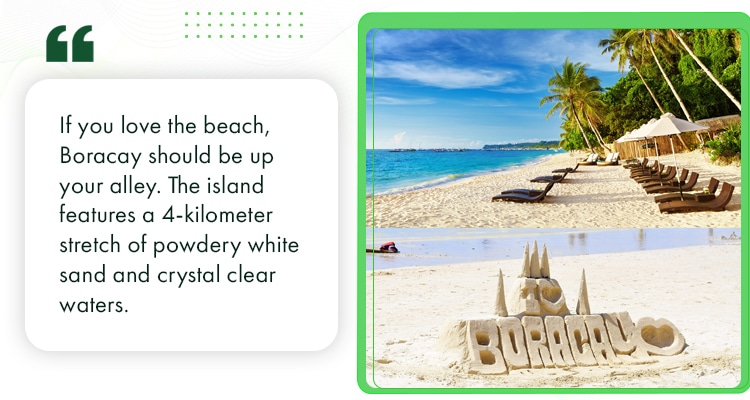
It also has the best sunset views and a range of water sports, including kite surfing, paddle boarding, and snorkeling. Boracay also has a vibrant nightlife with beachfront bars and restaurants serving delicious local cuisine.
Remote Working in Boracay
Digital nomads enjoy working in Boracay. They can stroll along the white sandy beaches after work and sip sunset cocktails at beachfront bars.
The island also has reliable, high-speed internet and many co-working spaces. This makes Boracay a perfect destination for professionals who want to work remotely while enjoying the island’s relaxed lifestyle.
Co-Working Spaces with a View of White Sand Beaches
Working feels a lot less stressful when you’re in Boracay. If you’re a digital nomad planning a long stay, here are some co-working spaces with spectacular beach views:
- Coco Cafe – Coco Cafe is one of the few air-conditioned coffee shops on the island where you can work remotely while relaxing near the beach. Unlike typical coffee shops, the tables are spaced out, providing more privacy and better focus.
- Cafe Maruja – You can also visit Cafe Maruja, a serene co-working space with beautiful views on White Beach. The place offers high-speed internet, cozy settings, and a relaxed vibe.
- The Sunny Side Cafe – If you enjoy working in coffee shops, check out the Sunny Side Cafe. It’s a great spot to work while enjoying the sun and their all-day breakfast options. It also features a beachfront view and bright, vibrant decor that captures the island vibe.
Affordable Housing and Long-Term Stay Options
While luxury hotels and resorts are all over the island, Boracay also offers various options for digital nomads with different budgets.
Here are several choices for affordable housing:
- Guesthouses and Hostels – Boracay has many guesthouses and hostels with budget-friendly rates starting at $15-20 a night. These accommodations offer basic amenities and are usually located near central beach areas.
- Local Rentals – You can also rent a house or room for a more immersive experience. Check websites like Airbnb, local real estate agents, and Facebook to find these rentals.
- Long-Term Stays in Resorts – If you have the budget, some resorts offer long-term stay packages at discounted rates. These packages often include utilities and sometimes meals, providing a resort-like experience at a more reasonable price.
Practical Considerations for U.S. Digital Nomads in the Philippines
The Philippines has much to offer, from white sand beaches to an affordable cost of living, making it worth visiting.
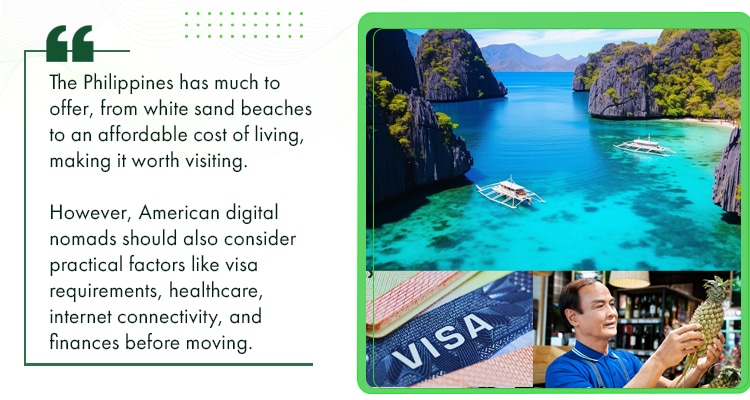
However, American digital nomads should also consider practical factors like visa requirements, healthcare, internet connectivity, and finances before moving.
Let’s take a look.
Visa Requirements and Extensions
Americans don’t need a visa to stay in the Philippines for up to 30 days. They just need:
- A valid return ticket to their home country or next destination; and
- A passport valid for at least six months beyond their stay in the Philippines.
However, U.S. digital nomads who are planning to stay for longer can extend their stay by 29 days, with further two-month extensions available for up to 36 months.
As of this writing, the Philippine government is considering a nomad visa to boost tourism. The visa would let foreign digital nomads live in the Philippines for up to 12 months while working remotely for employers abroad. It could also be renewed for another 12 months.
Once approved, the nomad visa would allow digital nomads to stay for longer without needing to extend their tourist visas or make visa runs to nearby countries after the 36-month limit.
Safety and Healthcare Tips for U.S. Citizens
The Philippines is a tropical country, with a climate that’s quite different from the U.S.
Because of this, American digital nomads planning to stay long-term should prioritize their health and safety, especially being thousands of miles from home.
Below is the digital nomad’s guide to working safely in the Philippines:
- Get Healthcare Insurance – The U.S. government doesn’t provide insurance for American citizens abroad. So, digital nomads traveling to the Philippines should get international health insurance with comprehensive medical coverage.
- Stay Up-to-Date with Vaccinations – It’s important to stay up-to-date on vaccinations, like measles and tetanus. The Centers for Disease Control and Prevention (CDC) also recommends vaccines for hepatitis A, typhoid, and rabies when traveling to the Philippines.
- Check the Embassy Website – Always check the U.S. Embassy and State Department websites for updated travel advisories. They provide important updates and announcements, especially during emergencies or crises.
- Respect Local Laws and Customs – Foreigners must follow local laws to avoid fines, jail time, or deportation. It’s also important to carry your passport or a copy of it at all times for ID checks.
- Avoid Flashing Valuables – As in any tourist spot, avoid displaying valuables in public and be cautious when using ATMs. Also, watch out for pickpockets in crowded areas, especially in cities or crowded beaches.
Internet, Connectivity, and SIM Card Options
The Philippines has a relatively good internet connection, especially in major cities like Manila, Cebu, and Davao, with average speeds of 50-90 Mbps.
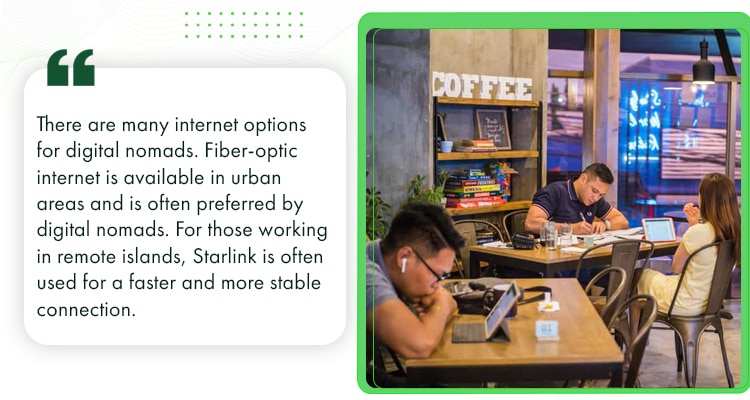
There are many internet options for digital nomads. Fiber-optic internet is available in urban areas and is often preferred by digital nomads. For those working in remote islands, Starlink is often used for a faster and more stable connection.
Wi-Fi is also available in many cafes, hotels, malls, and restaurants, but having a backup connection like a mobile data plan is a good idea. The main mobile network providers are Globe and Smart.
Globe has better coverage in urban areas, while Smart is better in rural regions. Both have SIM cards for smartphones as well. International roaming can be costly, so it’s more cost-effective to buy a local SIM card rather than rely on your U.S. mobile plan.
Navigating Finances: Banking and Currency Tips
The Philippine Peso (Php) is the official currency of the Philippines. Banknotes come in denominations of 50, 100, 500, and 1,000, while coins are available in 1, 5, 10, and 20 pesos.
As of writing, one U.S. dollar is equivalent to Php 55.55 and currency exchange services are available at airports, hotels, and local exchange shops. It’s typically cheaper to exchange currency at local shops rather than at airports for large amounts.
Meanwhile, credit and debit cards are widely accepted in cities, but smaller businesses and markets may only accept cash. Before withdrawing money, inform your U.S. bank about your travel plans to avoid having your cards blocked for suspicious activity.
Also, kindly note that foreign transaction fees may apply.
In addition, U.S. citizens must file taxes regardless of where they live. Thus, before moving to the Philippines to work remotely, consult a tax advisor to understand the tax implications of earning income abroad.
Frequently Asked Questions (FAQs)
Here are some of the most common questions American digital nomads ask when visiting the Philippines for work and leisure:
#1: Are There Any Specific Taxes or Legal Requirements for U.S. Digital Nomads Working in the Philippines?
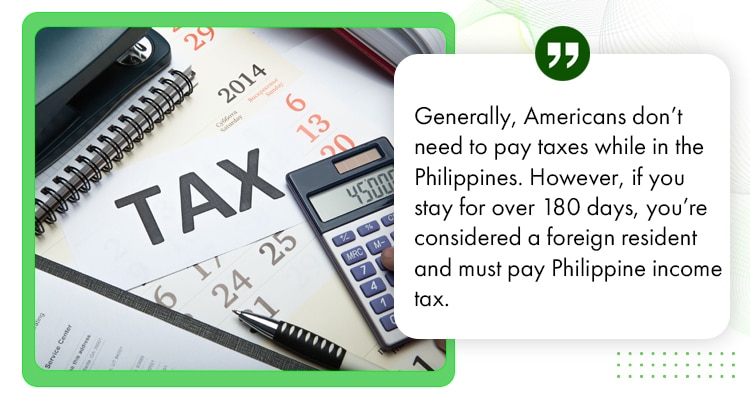
Generally, Americans don’t need to pay taxes while in the Philippines. However, if you stay for over 180 days, you’re considered a foreign resident and must pay Philippine income tax.
In addition to filing taxes with the IRS, you’ll need to file a tax return with the Bureau of Internal Revenue (BIR) in the Philippines. To avoid double taxation, you can use the Foreign Earned Income Exclusion (FEIE) and the Foreign Tax Credit.
#2: Can U.S. Digital Nomads Own Property or Rent Long-term in the Philippines?
Under Philippine laws, foreigners cannot own land directly, except through inheritance.
However, they can own up to 40% of the shares in a corporation that owns land. They can also buy buildings like a house, as long as the land it’s on is leased from a Filipino or a Filipino-owned corporation.
On the other hand, long-term rentals are widely available, with leases typically ranging from six months to one year or more. Landlords may require the following:
- Valid visa;
- Proof of legal stay in the Philippines;
- Valid ID;
- Proof of income; and
- Security deposit.
#3: What Are the Average Living Costs for U.S. Digital Nomads in the Philippines?
The living costs in the Philippines vary by location. In major cities like Manila and Cebu, monthly expenses range from $1,150-2,200, while in provinces and island towns, it’s typically around $860-1,900.
Transportation costs are also minimal, with jeepneys costing less than a dollar for every trip. Ride-hailing services such as Grab, Angkas, and Move It are available, but are slightly more expensive.
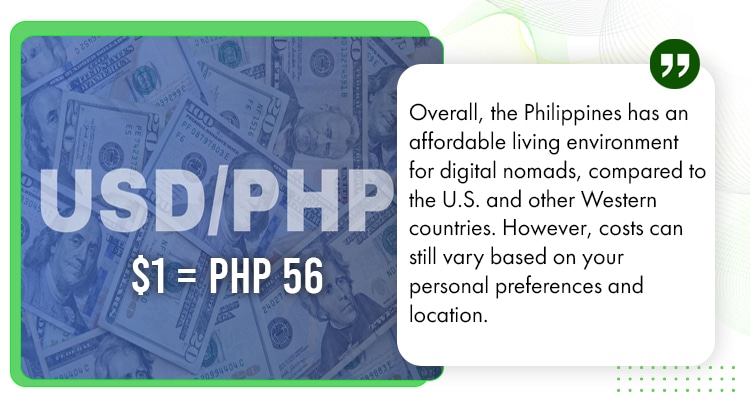
Overall, the Philippines has an affordable living environment for digital nomads, compared to the U.S. and other Western countries. However, costs can still vary based on your personal preferences and location.
#4: Can U.S. Digital Nomads Stay Long-Term in the Philippines?
Yes! Aside from the standard tourist visa with allowable extensions, digital nomads can explore the Special Work Permit (SWP) for temporary business activities. However, this may not be ideal for all remote work situations.
To find the best visa option, it’s recommended to consult an immigration lawyer or expert who can guide you through the options and ensure compliance with Philippine regulations.
Conclusion
Remote work is truly rewarding, especially when you can travel the world while growing your business.
Many American digital nomads do just that. With the support of their remote teams, including Filipino virtual or admin assistants, they can keep running their companies while exploring different countries and cultures.
So, whether you prefer the bustling cities like Manila and Cebu or working by the beach in Siargao and Boracay, the Philippines, with its 7,640 islands, is the place to go.
Syrine studies law while working as a content writer. Outside of writing and studying, she tutors, plans events, and browses social media. In 2021, she published Stellar Thoughts.

